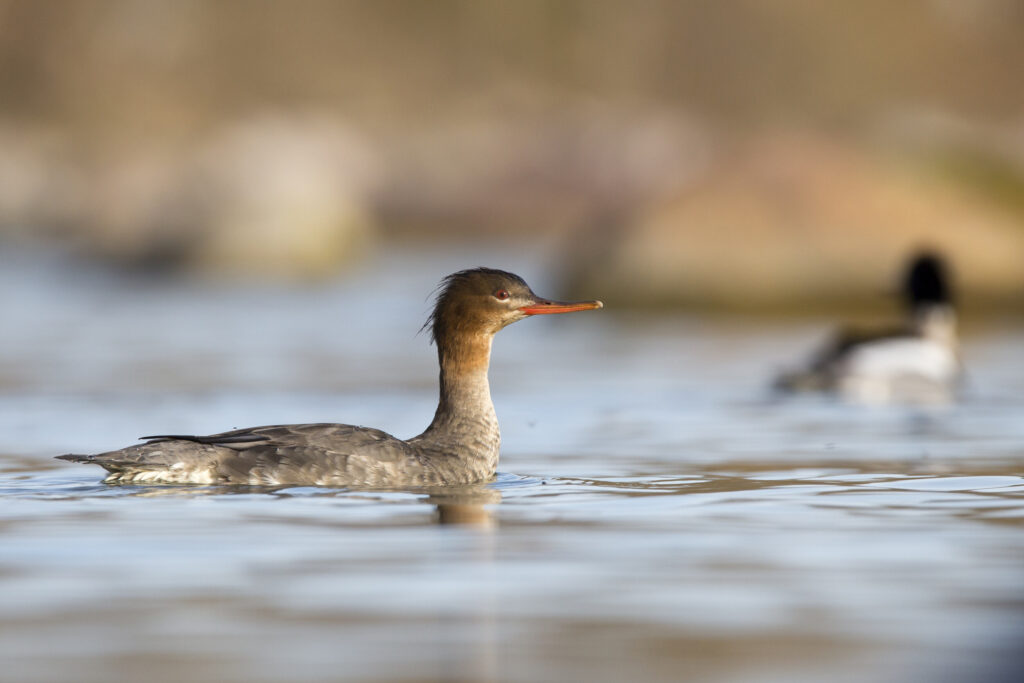Red-breasted merganser
Red-breasted merganser. Photo: Roger Erikson
Introduction
Latin Mergus serrator L.
Estonian Rohukoskel
Also known as: sawbill
Status in Estonia
Breeding, migratory and wintering bird.
Description
The red-breasted merganser is similar to a goosander but slimmer. The beak and neck are thinner, and the nape is more straight and fluffy, resulting in a somewhat small-headed appearance. The male’s nuptial plumage has a black head with a green sheen, a white neck, a rusty brown chest with black flecks, a black front with distinguishing white spots, a black top area and a grey side body. In flight, there is a huge white spot on the bend of the wing. The female is similar to the female goosander, but there is a lack of a distinct border between the brown head and the off-white neck, the lighter throat patch has a more dispersed edge, the base of the beak is thin, the nape is shorter and more spread out, the head is more yellowish brown, the face plumage has more stripes, the back is darker and brown-toned and the sides of the body aren’t pure grey. The male bird in eclipse plumage resembles the female bird, but with more white on the wings. Juveniles are similar to female birds but with a duller red beak and a shorter tuft.
Size
Body length 52–58 cm, wingspan 69–82 cm, body mass 0.8–1.1 kg.

Red-breasted merganser (female). Photo: Roger Erikson
Similar species
Goosander.
Distribution
It inhabits the northern part of Eurasia, North America and the southern half of Greenland. In some places, the area extends into the temperate zone, but it does not typically reach south of 50 degrees latitude. However, in the latter half of the twentieth century, the species began to progressively migrate south and it currently breeds in small numbers in the Netherlands, France and Ukraine, with a few odd pairs in Switzerland. It is spread throughout Estonia, particularly in the islands of Western Estonia and along the coast of Northern Estonia.
Population
Estonia has 300–500 breeding pairs.
Occurrence in Estonia
Depending on the year, 500–2500 red-breasted mergansers spend the winter in our ice-free sea. Those who migrated will begin to return at the end of March. The spring migration lasts until mid-May, whereas the autumn migration lasts from September to October. Birds migrate in small flocks, primarily at night, thus the migration goes unobserved.
Diet
It feeds mainly on fish, aquatic insects, crustaceans and frogs.
Habitat
It is primarily found on small islands but sometimes breeds on capes and in coves along the mainland.
Nesting
The nest is built in tall grass (nettles, umbellifers, burdocks, dew berries) or under a mountain currant or juniper shrub; it prefers an area with stones beneath the plants or where the bushes grow directly between the stones. It also feels safe on the outskirts of a black-headed gull or tern colony. The edge of the nest is lined with its own down feathers. The female lays 8–12 pale or light green eggs, which she incubates for 29–35 days, between late May and early June. The male bird leaves to moult at the beginning of incubation. After hatching, the chicks leave the nest with their mother after a day or two and head to the shallow coastal sea. A so-called ‘nursery’ is often created, in which the chicks of multiple broods are kept together and a single mother bird takes care of them. After about 60 days, the chicks learn to fly.
Conservation status and protection
Not under protection. A variety of nest predators, particularly foxes and raccoons on the islands, pose a threat. Seagulls also find well-hidden nests. Excessive overgrowth of nesting islands, especially juniper patches and afforestation, has a significant impact on the population. Because of the late nesting, summer visitors to the islands may disturb the nesting process.
Distribution and population in Lääne County
The red-breasted merganser is a common migratory bird and an uncommon breeding bird on the coast of Lääne County. This species is primarily found on the sea coast; it rarely occurs in inland bays. In Matsalu, the red-breasted mergansers are most visible on Cape Puise. Several pairs of red-breasted mergansers nest in the islets surrounding the Puise Peninsula (for example, Kakrarahu).
Red-breasted mergansers are best observed on Cape Põõsaspea. You can also observe their migration there at the end of summer and in autumn.
